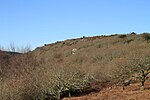Moretonhampstead

Moretonhampstead (anciently Moreton Hampstead) is a market town, parish and ancient manor in Devon, situated on the north-eastern edge of Dartmoor, within the Dartmoor National Park. The parish now includes the hamlet of Doccombe (), and it is surrounded clockwise from the north by the parishes of Drewsteignton, Dunsford, Bridford, Bovey Tracey, Lustleigh, North Bovey and Chagford.At the 2011 census the population of the parish was 1,703, and Moorland electoral ward, in which Moretonhampstead lies, had a population of 2,806. The parish church is dedicated to St. Andrew. Along with a few other places in Devon, it is one of the longest place names in England with 16 letters. Moretonhampstead is twinned with Betton in France.
Excerpt from the Wikipedia article Moretonhampstead (License: CC BY-SA 3.0, Authors, Images).Moretonhampstead
Court Street, Teignbridge Moretonhampstead
Geographical coordinates (GPS) Address Nearby Places Show on map
Geographical coordinates (GPS)
| Latitude | Longitude |
|---|---|
| N 50.6603 ° | E -3.7671 ° |
Address
Court Street 19
TQ13 8NE Teignbridge, Moretonhampstead
England, United Kingdom
Open on Google Maps









